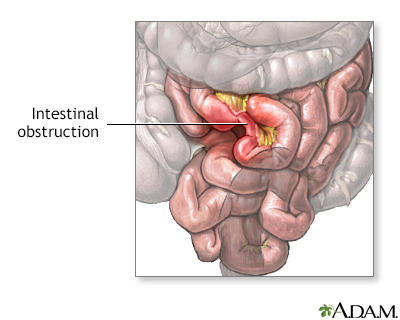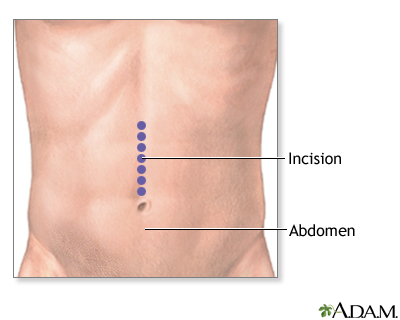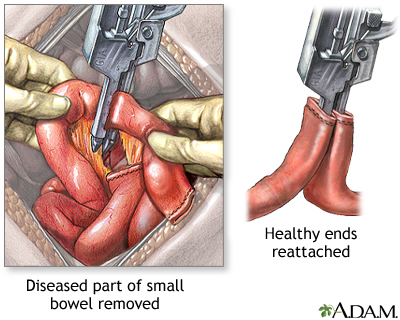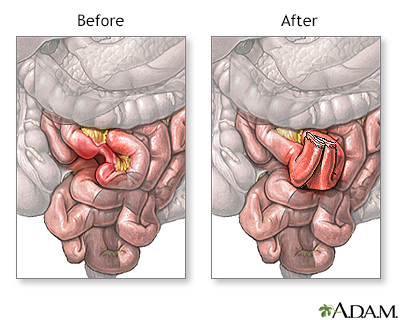Small bowel resection
| Normal anatomy |
|
The small intestine absorbs much of the liquid from foods. There are three parts of the small intestine, the duodenum, the ileum and the jejunum.
|
|
| Indications |
|
Resection of the small bowel may be recommended for:
- Blockage of the intestine (intestinal obstruction) due to scar tissue or deformities
- Bleeding, infection, or ulcers due to inflammation of the small intestine (regional ileitis, regional enteritis, Crohn's disease)
- Injuries
- Cancer
- Precancerous polyps
|
|
| Incision |
|
The patient is deep asleep and pain-free (general anesthesia). An incision is made into the abdomen.
|
|
| Procedure |
|
The diseased part of the small intestine (ileum) is removed. The two healthy ends are then sewn back together and the incision is closed.
If it is necessary to spare the intestine from its normal digestive work while it heals, a temporary opening (stoma) of the intestine onto the abdomen (ileostomy) may be done. A temporary ileostomy will be closed and repaired later. If a large portion of the bowel is removed, the ileostomy may be permanent.
The ileum absorbs much of the fluid from foods. When the large intestine is bypassed by an ileostomy, the patient should expect liquid stool (feces). The constant or frequent drainage of liquid stool can cause the skin around the ileostomy to become inflamed. Careful skin care and a well-fitting ileostomy bag can reduce this irritation.
|
|
| Aftercare |
|
The outcome depends on the disease. Most patients will stay in the hospital for 5 to 7 days. Complete recovery from surgery may take 2 months. During the first few days after surgery, eating is restricted.
|
|

|
Review Date:
1/21/2025
Reviewed By:
Jonas DeMuro, MD, Diplomate of the American Board of Surgery with added Qualifications in Surgical Critical Care, Assistant Professor of Surgery, Renaissance School of Medicine, Stony Brook, NY. Review provided by VeriMed Healthcare Network. Also reviewed by David C. Dugdale, MD, Medical Director, Brenda Conaway, Editorial Director, and the A.D.A.M. Editorial team. |
The information provided herein should not be used during any medical emergency or for the diagnosis or treatment of any medical condition. A licensed medical professional should be consulted for diagnosis and treatment of any and all medical conditions. Links to other sites are provided for information only -- they do not constitute endorsements of those other sites. No warranty of any kind, either expressed or implied, is made as to the accuracy, reliability, timeliness, or correctness of any translations made by a third-party service of the information provided herein into any other language. © 1997-
A.D.A.M., a business unit of Ebix, Inc. Any duplication or distribution of the information contained herein is strictly prohibited.
© 1997-

All rights reserved.






